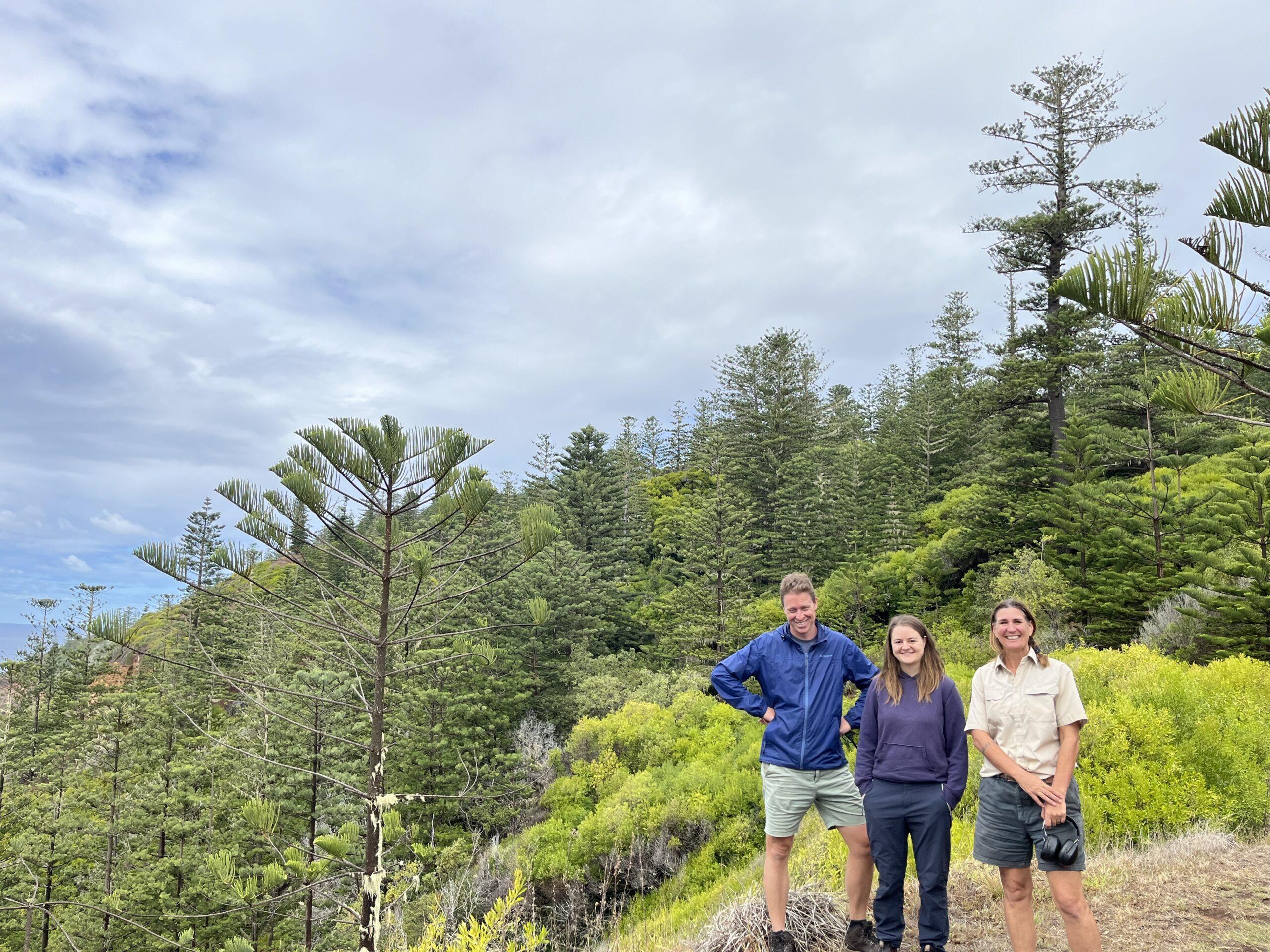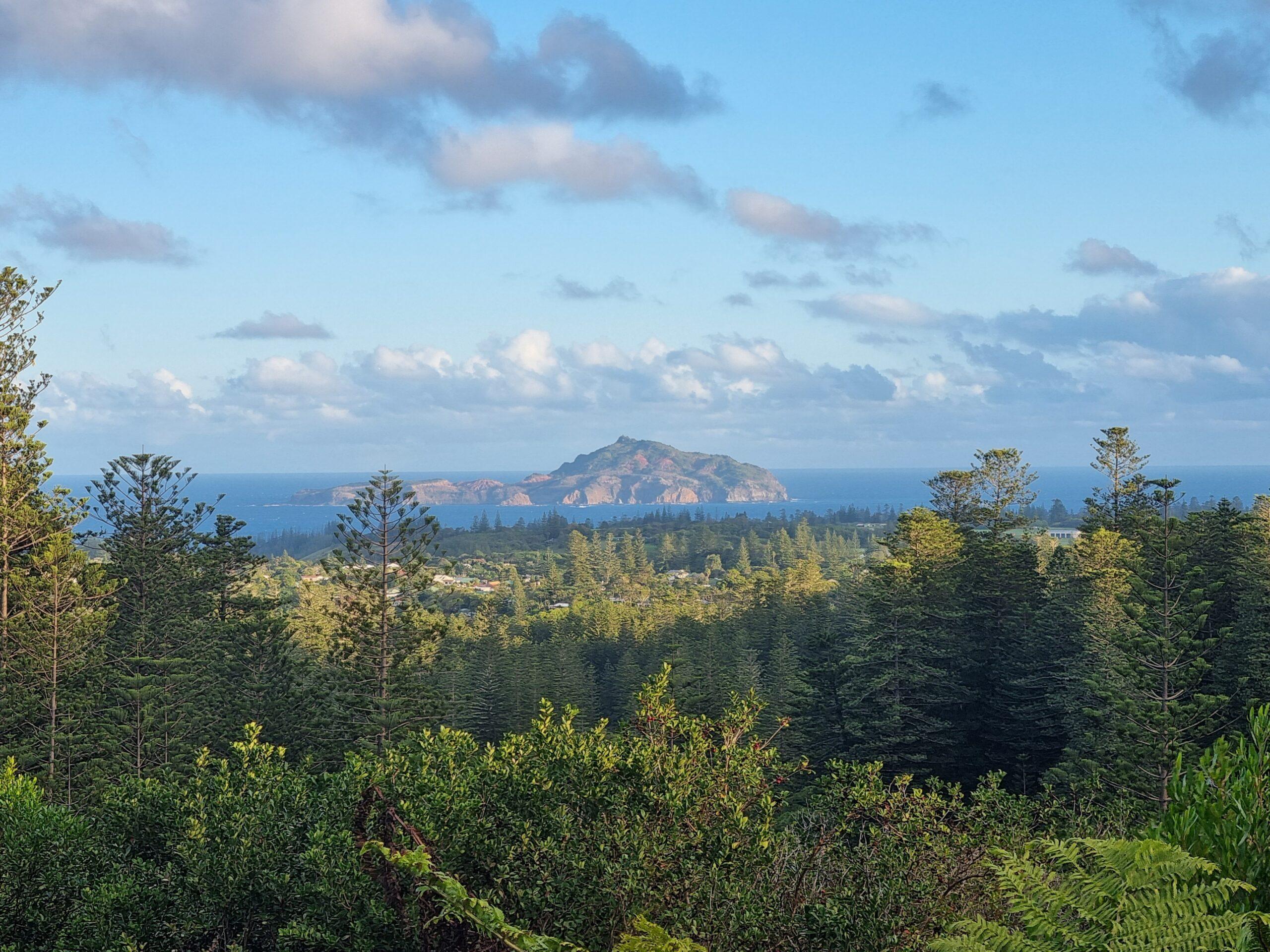30 July 2024
Scientists have completed their first field trip to Norfolk Island as part of a NESP Resilient Landscapes Hub project which aims to protect rare birds by tracking the movements of introduced rodents on the island.
Norfolk Island is home to pines tree, jagged cliffs, and a unique array of birds – including the endangered Norfolk Island green parrot. But, historically, introduced rodents have led to the extinction of multiple bird species.
A project funded by the National Environmental Science Program’s Resilient Landscapes Hub is helping to protect native species by studying how introduced rats and mice move within the Norfolk Island National Park and nearby areas.
This data can inform future actions to prevent rat predation, and potentially pave the way for full-scale rewilding – reintroducing species that have gone extinct on the island.

Dr Darren Southwell, Dr Finella Dawlings, and Mel Wilson (Natural Resource Manager, Norfolk Island National Park) stand in front of the island’s famous pines, in the Norfolk Island National Park (Image by Matt Hayward)
University of Newcastle researchers, Dr Finella Dawlings, Dr Darren Southwell and project lead, Professor Matt Hayward recently travelled to Norfolk Island to test various ways of capturing and tracking feral rodents.
“The goal of my first field trip was to trap and track Polynesian rats, black rats and house mice. Rodents on Norfolk are reportedly tricky to live trap, so we were really trying to figure out how to go about it,” said Dr Dawlings, a post-doctoral scientist who recently moved to the island paradise to undertake 2 years of rodent monitoring.
The scientists set up hundreds of Elliot traps: small metal traps designed to capture live rodents.
In the first week, the team caught and tracked a handful of mice; since then, Dr Dawlings has caught dozens of mice and Polynesian rats. Black rats have been harder to come by, likely because they are almost entirely arboreal (tree-dwelling) on Norfolk.
Once trapped, the team tracked the fine-scale movements of mice by coating the rodent’s back with a fluorescent yellow, non-toxic tracking powder. When released, the yellow powder would fall of the mouse and rub onto plants. Later, at night, the team returned to each site with a UV torch, which illuminated the powder on the vegetation.
This method helps scientists to track and understand fine-scale rodent moments. And the early results from tracking captured house mice are promising.
“Currently I’ve been able to track their movements for up to about 10 metres with this method, and I am trialling in different vegetation types to see where it can provide useful information,” said Dr Dawlings.
Fine-scale movements help park managers to optimise their baiting efforts by determining whether the rodents are reinvading recently-baited control sites from nearby, or if they are breeding up after the baiting ends.
The researchers also attached some GPS radio-trackers to the caught and released rodents, for long-term tracking.
“Norfolk Island National Park staff are using all available methods to reduce rodents and protect their precious heritage; understanding reinvasion routes and frequency of rodents will improve their ability to do so,” said Professor Hayward.
Ultimately, the researchers are interested in learning how the rodent populations respond to the National Park’s current baiting regime, funded by Parks Australia.
This project was co-designed by a team led by Professor Matt Hayward, Associate Professor Andrea Griffin, Dr Nick Macgregor (Parks Australia), and the Natural Resources Management team from Norfolk Island National Park.
The team is working with land holders, volunteers, local council and regional environmental bodies.
As they say, no researcher is an island!

1600 km northeast of Sydney, Norfolk Island is home to a unique array of species, including endemic birds that are threatened by rats and mice (Image by Professor Matt Hayward)
Banner photo: A camera trap captures a rat preying on eggs and chicks of each endemic song bird species on Norfolk Island (Image by Allie Nance).
Want to know more about the Resilient Landscapes Hub's activities and our research into practical solutions to environmental problems? Stay informed about activities, research, publications, events and more through the Hub newsletter.
"*" indicates required fields